From January 1, 1874 to July 1, 1918—nearly a 44-year period—Luxembourg’s domestic postal card rate was five centimes. On July 1, 1918, the rate was increased to 7½ centimes. The five-centime Écusson postal card shown here was posted a day later, on July 2, 1918, from Diekirch to Wiltz, where a revenue conscious postal clerk indicated the deficiency with a handstamped “T” [meaning taxe]. Received at Wiltz the same day, a postal clerk collected the prescribed taxe or penalty—twice the 2½-centime deficiency. Payment of the penalty is evidenced by the five-centime taxe (postage due) stamp that was affixed.
The card to the left shows a similar underfranking nearly two months later. Posted from Remich in the Moselle Valley wine country on August 26, 1918 to Kayl, a small southern village in the iron mining region, where it was received the following day, the underfranked card has been correctly taxed twice the 2½-centime deficiency as evidenced by the five-centime taxe stamp.
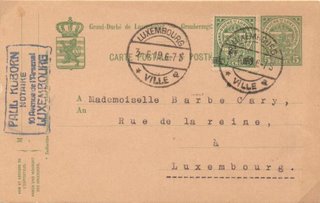
Luxembourg did not issue a 7½-centime postal card until April 8, 1919. Consequently, for domestic use users had to uprate the five-centime cards with a 2½-centime adhesive. An uprated example is shown above. Used locally within Luxembourg-Ville on June 3, 1919, the card was uprated with a five-centime adhesive surcharged to 2½ centimes.

Shown above is an example of the 7½-centime postal card issued in 1919 properly used from Luxembourg-Ville to Grevenmacher on March 22, 1920.

The 7½-centime domestic postal card rate remained in effect until April 12, 1920, when it was increased to ten centimes. The 7½-centime card above was used from Pétange to Luxembourg-Gare 12 days later on April 24, 1920. As the rate had increased, it was taxed five centimes (the penalty being double the 2½-centime deficiency), with payment of the taxe shown by a five-centime taxe stamp.
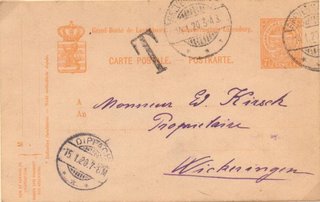
The card above, posted from Grevenmacher, January 14, 1920, to Wickrange [post: Dippach] the following day, was also marked with a "T" to be taxed on arrival. However, no taxe or postage due was collected (as shown by the absence of a postage due stamp) because the increase had not yet gone into effect. So how would we explain the erroneous taxe mark? Perhaps the postal clerk in Grevenmacher, seeing the German spelling of Wickrange [Wickringen], thought the card was addressed to a town in Germany, for which the rate at the time would have been ten centimes.
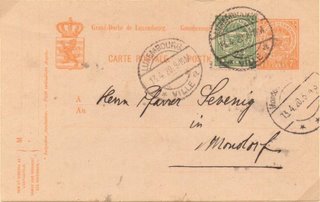
The card above, which was posted from Luxembourg-Ville to Mondorf-les-Bains on April 13, 1920, was used one day after the rate increase took effect and was properly uprated with a 2½-centime adhesive surcharged to five centimes!
Commentary
During the first half of the 20th century, Luxembourg issued nearly 200 face different postal cards, all of which bear an imprint of the country's Coat of Arms or Écusson. Most can still be obtained at very modest prices, although some of the surcharged viewcards are scarce. In addition to cards showing the postal rates, you will find these cards used to pay special fees (registry, insurance, COD, and special delivery). Of course, as with all Luxembourg postal cards, finding uses to interesting destinations will be challenging. Uses beyond Europe (even to the USA) are uncommon. You will also find varieties--shades, papers and offsets, for example. These cards will also enable you to collect a broad range of cancels and auxiliary marks--single and double circles, bridges with and without bars, AEF and other censor marks, etc. And last, you may even find examples that were chemically painted by censors looking for invisible writing, as the example below shows!
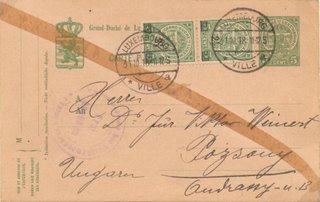
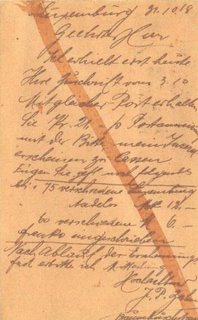 This five-centime card was posted from Luxembourg-Ville, October 31, 1918, to Pozsany, Hungary, just days before the American and French troops liberated Luxembourg. It's uprated with a pair of five-centime adhesives surcharged to 2½ centimes to pay the ten-centime UPU rate. The German censor at Trier [purple circular censor mark] has used a chemical solution to test the card for the presence of invisible writing.
This five-centime card was posted from Luxembourg-Ville, October 31, 1918, to Pozsany, Hungary, just days before the American and French troops liberated Luxembourg. It's uprated with a pair of five-centime adhesives surcharged to 2½ centimes to pay the ten-centime UPU rate. The German censor at Trier [purple circular censor mark] has used a chemical solution to test the card for the presence of invisible writing.
Some would say these Écusson cards are boring or too common to bother with. These collectors lack philatelic knowledge. A fine showing of these cards will enable you to garner a nice award at a local, regional or even a national stamp exhibition!
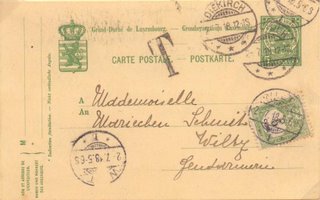

No comments:
Post a Comment